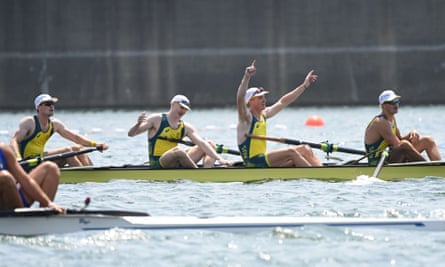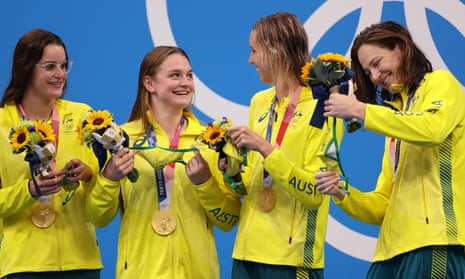There are two striking characteristics about Australia’s Tokyo 2020 medal tally. The first is the number of gold medals: 17 – equal with the nation’s best previous haul at the 2004 Olympics in Athens. The second is the differential between the number of golds and silvers: 17 first-place performances and seven second places. Among the top 10 countries on the Tokyo medal tally, it is the best gold-to-silver ratio.
“One of the big issues that was identified in Rio was performing under pressure – converting opportunities to medals,” says Peter Conde, director of the Australian Institute of Sport, a government agency tasked with funding and guiding high-performance sport in Australia. “I think you’d have to say that our athletes and our teams have really performed under pressure at these Games.”
After bumper medal hauls at Sydney 2000, Athens 2004 and Beijing 2008, a dip in performance at London 2012 meant Australia’s athletes had travelled to Rio in 2016 hoping to arrest a slide down the table. They did not succeed – Australia’s 10th-place finish was the worst since 1992. The result led to much soul-searching within Australia’s multi-layered high-performance system.
“No one likes not doing their best,” says Australian Olympic Committee chief executive, Matt Carroll. “Off the back of Rio, the sports and the athletes dug deep – they looked back at their performance and wanted to improve. They’ve been striving to improve and they have improved. When you haven’t gone well, you go back to square one and get stuck into it, and that’s what they have done.”
The disappointment in Rio saw Conde appointed to the AIS and a number of sports undertake governance and high-performance shake-ups. Government funding levels have largely stayed the same (at about A$250m annually), although changes to its distribution and timing, and some additional money for development pathways and athlete wellbeing, have been welcomed by sporting peak bodies.
But although a significant funding boost was not on the cards, Conde, Carroll and their counterparts have worked tirelessly to ensure there would be no repeat of Rio. This included both wider structural reform and small details, like providing a dedicated coffee cart in the Australian section of the athletes’ village.
Speaking to the Guardian from Australia – Conde did not travel to Tokyo – the AIS director says the nation’s medal performance was in line with expectations. “I’m not surprised,” he says. “It’s within the range of projections that we had.” The AIS no longer makes its projections public ahead of the Games, scrapping that transparency after Rio on the basis it put unnecessary pressure on athletes.

Expected or not, Australia’s gold rush in Tokyo has been remarkable, particularly when the difference between Olympic success and failure can be miniscule. In the women’s 4x100m medley swimming relay, for example, Australia beat the United States to the wall in less than two tenths of a second. A bold relay changeover from anchor swimmer Cate Campbell (0.03s) was the difference between gold and silver (her American opponent, Abbey Weitzeil, took 0.38s to leave the blocks).
For this reason, Conde says Australia’s golden run in Tokyo is not “explained by one thing”. But the high performance head honcho points to three factors that he says contributed to Australian success in Tokyo. “I always come back to three different things at a high level,” he says. “One is people, two is system and three is attention to detail.
Despite its relatively small population (Australia is the second-smallest country of any of the top 10 in the medal tally, behind only the Netherlands), the country has a long and proud sporting history. What has changed, says Conde, is new emphasis on those around them.
“You can’t do this without outstanding athletes,” he says. “But we’ve had a lot of outstanding athletes over long periods of time. We have to support them with outstanding coaches and support staff and have outstanding leadership.”
Conde and his team have also overseen wider systemic reform. They have ensured funding and support for new Olympic sports (Australia won gold medals in BMX freestyle and skateboarding, and bronze in surfing) and implemented innovative strategies in areas where Australia have not traditionally excelled. They have, for example, brought together judo, boxing and taekwondo under a single aggregate strategy; Conde describes Harry Garside’s bronze medal in boxing – Australia’s first in decades – as “outstanding”.
It helped, too, that historical areas of strength were in fine form: nine gold medals – more than 50% of Australia’s total – came at the Tokyo Aquatics Centre in the Dolphins’ best-ever performance. Two came from sailing and another two in rowing. But while Australia’s gold medals were limited to seven sports, Tokyo 2020 also brought wider success: three medals at the athletics (plus a range of captivating performances), the Boomers’ first bronze in the men’s basketball and a return to the podium for the Kookaburras in the men’s hockey.

In Tokyo, the AIS and AOC doubled down on crossing the i’s and dotting the t’s. The two organisations came together to form a performance committee, taking care of everything from a sports science-led heat-mitigation strategy to decorations in the Australian section of the Olympic village (including a range of Indigenous Australian artwork). The Australian team even brought their own ultra-fast Covid-19 testing machine to Tokyo, although ultimately no team member tested positive.
“Every little bit helps,” says Carroll. “That’s what we’re here to do – to get the teams to Games and make sure they’re successful. We’re not just providing the uniforms.”
All of which helps explain Australia’s bumper Tokyo 2020. But strategy, funding and support only go so far. So often the difference between gold and silver is about how an individual athlete responds to pressure in the crucial moments.
Quick GuideHow do I sign up for sport breaking news alerts?
Show
- Download the Guardian app from the iOS App Store on iPhone or the Google Play store on Android by searching for 'The Guardian'.
- If you already have the Guardian app, make sure you’re on the most recent version.
- In the Guardian app, tap the Menu button at the bottom right, then go to Settings (the gear icon), then Notifications.
- Turn on sport notifications.
In 2019, the AIS convened a group of Olympic alumni – collectively accounting for 48 gold medals – to mentor Tokyo 2020 athletes. “We [brought] 40 gold medal alumni together to work with current athletes to share their stories, share their insight,” Conde explains. “Some real household names played a huge part in helping prepare.”
The mentoring paid off in spades. Thirteen of Australia’s gold medals in Tokyo were won by Olympic debutants (either individually or as part of teams). Conde hopes it will be a virtuous cycle, as this latest generation helps the next one. With a home Olympics in Brisbane scheduled for 2032, and the usual funding and medal boost associated with hosting the Games, this could be a new golden era for Australian Olympians.

Comments (…)
Sign in or create your Guardian account to join the discussion